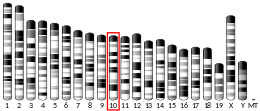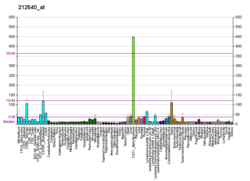CDC34
CDC34 is a gene encoding a protein product that has ubiquitin conjugating activity. CDC34 was originally discovered by work in baker's yeast as a gene that has a role in the cell division cycle. Cdc34 in yeast targets numerous substrates (Sic1, Far1, Cln1, Cln2) for ubiquitin mediated degradation. Ubiquitin-conjugating enzyme E2 R1 is a protein that in humans is encoded by the CDC34 gene.[5][6][7]
The protein encoded by this gene is a member of the ubiquitin-conjugating enzyme family. Ubiquitin-conjugating enzyme catalyzes the covalent attachment of ubiquitin to other proteins. This protein is a part of the large multiprotein complex, which is required for ubiquitin-mediated degradation of cell cycle G1 regulators, and for the initiation of DNA replication.[7]
Interactions
CDC34 has been shown to interact with CSNK2B,[8] BTRC[9][10] and CDK9.[11]
References
- GRCh38: Ensembl release 89: ENSG00000099804 - Ensembl, May 2017
- GRCm38: Ensembl release 89: ENSMUSG00000020307 - Ensembl, May 2017
- "Human PubMed Reference:". National Center for Biotechnology Information, U.S. National Library of Medicine.
- "Mouse PubMed Reference:". National Center for Biotechnology Information, U.S. National Library of Medicine.
- Plon SE, Leppig KA, Do HN, Groudine M (Dec 1993). "Cloning of the human homolog of the CDC34 cell cycle gene by complementation in yeast". Proc Natl Acad Sci U S A. 90 (22): 10484–8. Bibcode:1993PNAS...9010484P. doi:10.1073/pnas.90.22.10484. PMC 47801. PMID 8248134.
- Gazdoiu S, Yamoah K, Wu K, Escalante CR, Tappin I, Bermudez V, Aggarwal AK, Hurwitz J, Pan ZQ (Oct 2005). "Proximity-induced activation of human Cdc34 through heterologous dimerization". Proc Natl Acad Sci U S A. 102 (42): 15053–8. Bibcode:2005PNAS..10215053G. doi:10.1073/pnas.0507646102. PMC 1242854. PMID 16210246.
- "Entrez Gene: CDC34 cell division cycle 34 homolog (S. cerevisiae)".
- Block, K; Boyer T G; Yew P R (Nov 2001). "Phosphorylation of the human ubiquitin-conjugating enzyme, CDC34, by casein kinase 2". J. Biol. Chem. United States. 276 (44): 41049–58. doi:10.1074/jbc.M106453200. ISSN 0021-9258. PMID 11546811.
- Semplici, Francesca; Meggio Flavio; Pinna Lorenzo A; Oliviero Salvatore (Jun 2002). "CK2-dependent phosphorylation of the E2 ubiquitin conjugating enzyme UBC3B induces its interaction with beta-TrCP and enhances beta-catenin degradation". Oncogene. England. 21 (25): 3978–87. doi:10.1038/sj.onc.1205574. ISSN 0950-9232. PMID 12037680.
- Cenciarelli, C; Chiaur D S; Guardavaccaro D; Parks W; Vidal M; Pagano M (Oct 1999). "Identification of a family of human F-box proteins". Curr. Biol. ENGLAND. 9 (20): 1177–9. doi:10.1016/S0960-9822(00)80020-2. ISSN 0960-9822. PMID 10531035.
- Kiernan, R E; Emiliani S; Nakayama K; Castro A; Labbé J C; Lorca T; Nakayama Ki K; Benkirane M (Dec 2001). "Interaction between cyclin T1 and SCF(SKP2) targets CDK9 for ubiquitination and degradation by the proteasome". Mol. Cell. Biol. United States. 21 (23): 7956–70. doi:10.1128/MCB.21.23.7956-7970.2001. ISSN 0270-7306. PMC 99964. PMID 11689688.
External links
- Human CDC34 genome location and CDC34 gene details page in the UCSC Genome Browser.
Further reading
- King RW, Deshaies RJ, Peters JM, Kirschner MW (1997). "How proteolysis drives the cell cycle". Science. 274 (5293): 1652–9. Bibcode:1996Sci...274.1652K. doi:10.1126/science.274.5293.1652. PMID 8939846.
- Pagano M (1997). "Cell cycle regulation by the ubiquitin pathway". FASEB J. 11 (13): 1067–75. PMID 9367342.
- Lisztwan J, Marti A, Sutterlüty H, et al. (1998). "Association of human CUL-1 and ubiquitin-conjugating enzyme CDC34 with the F-box protein p45(SKP2): evidence for evolutionary conservation in the subunit composition of the CDC34-SCF pathway". EMBO J. 17 (2): 368–83. doi:10.1093/emboj/17.2.368. PMC 1170388. PMID 9430629.
- Song A, Wang Q, Goebl MG, Harrington MA (1998). "Phosphorylation of nuclear MyoD is required for its rapid degradation". Mol. Cell. Biol. 18 (9): 4994–9. PMC 109084. PMID 9710583.
- Gonen H, Bercovich B, Orian A, et al. (1999). "Identification of the ubiquitin carrier proteins, E2s, involved in signal-induced conjugation and subsequent degradation of IkappaBalpha". J. Biol. Chem. 274 (21): 14823–30. doi:10.1074/jbc.274.21.14823. PMID 10329681.
- Pati D, Meistrich ML, Plon SE (1999). "Human Cdc34 and Rad6B ubiquitin-conjugating enzymes target repressors of cyclic AMP-induced transcription for proteolysis". Mol. Cell. Biol. 19 (7): 5001–13. doi:10.1128/mcb.19.7.5001. PMC 84326. PMID 10373550.
- Seol JH, Feldman RM, Zachariae W, et al. (1999). "Cdc53/cullin and the essential Hrt1 RING-H2 subunit of SCF define a ubiquitin ligase module that activates the E2 enzyme Cdc34". Genes Dev. 13 (12): 1614–26. doi:10.1101/gad.13.12.1614. PMC 316801. PMID 10385629.
- Read MA, Brownell JE, Gladysheva TB, et al. (2000). "Nedd8 modification of cul-1 activates SCF(beta(TrCP))-dependent ubiquitination of IkappaBalpha". Mol. Cell. Biol. 20 (7): 2326–33. doi:10.1128/MCB.20.7.2326-2333.2000. PMC 85397. PMID 10713156.
- Reymond F, Wirbelauer C, Krek W (2000). "Association of human ubiquitin-conjugating enzyme CDC34 with the mitotic spindle in anaphase". J. Cell Sci. 113 (10): 1687–94. PMID 10769200.
- Charrasse S, Carena I, Brondani V, et al. (2000). "Degradation of B-Myb by ubiquitin-mediated proteolysis: involvement of the Cdc34-SCF(p45Skp2) pathway". Oncogene. 19 (26): 2986–95. doi:10.1038/sj.onc.1203618. PMID 10871850.
- Strack P, Caligiuri M, Pelletier M, et al. (2000). "SCF(beta-TRCP) and phosphorylation dependent ubiquitinationof I kappa B alpha catalyzed by Ubc3 and Ubc4". Oncogene. 19 (31): 3529–36. doi:10.1038/sj.onc.1203647. PMID 10918611.
- Duan W, Sun B, Li TW, et al. (2001). "Cloning and characterization of AWP1, a novel protein that associates with serine/threonine kinase PRK1 in vivo". Gene. 256 (1–2): 113–21. doi:10.1016/S0378-1119(00)00365-6. PMID 11054541.
- Block K, Boyer TG, Yew PR (2001). "Phosphorylation of the human ubiquitin-conjugating enzyme, CDC34, by casein kinase 2". J. Biol. Chem. 276 (44): 41049–58. doi:10.1074/jbc.M106453200. PMID 11546811.
- Wu K, Chen A, Tan P, Pan ZQ (2002). "The Nedd8-conjugated ROC1-CUL1 core ubiquitin ligase utilizes Nedd8 charged surface residues for efficient polyubiquitin chain assembly catalyzed by Cdc34". J. Biol. Chem. 277 (1): 516–27. doi:10.1074/jbc.M108008200. PMID 11675391.
- Kiernan RE, Emiliani S, Nakayama K, et al. (2001). "Interaction between cyclin T1 and SCF(SKP2) targets CDK9 for ubiquitination and degradation by the proteasome". Mol. Cell. Biol. 21 (23): 7956–70. doi:10.1128/MCB.21.23.7956-7970.2001. PMC 99964. PMID 11689688.
- Semplici F, Meggio F, Pinna LA, Oliviero S (2002). "CK2-dependent phosphorylation of the E2 ubiquitin conjugating enzyme UBC3B induces its interaction with beta-TrCP and enhances beta-catenin degradation". Oncogene. 21 (25): 3978–87. doi:10.1038/sj.onc.1205574. PMID 12037680.
- Strausberg RL, Feingold EA, Grouse LH, et al. (2003). "Generation and initial analysis of more than 15,000 full-length human and mouse cDNA sequences". Proc. Natl. Acad. Sci. U.S.A. 99 (26): 16899–903. Bibcode:2002PNAS...9916899M. doi:10.1073/pnas.242603899. PMC 139241. PMID 12477932.






